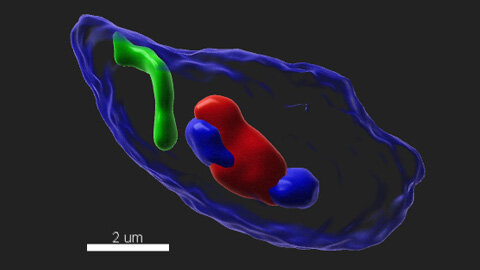Chromosomes occupy specific regions of the cell nucleus called chromosome territories. In somatic cells, scientists have observed that there is a correlation between this positioning and genome regulation. In fact, alterations in chromosome distribution have been related to certain diseases. Nevertheless, there are very few studies on chromosome territoriality in the cells that originate oocytes and spermatozoa (germ cells); cells that are subjected to a specific cell division process called meiosis.
In a recent study addressed by the Genetics of Male Fertility research group of the Cell Biology Unit at the Universitat Autònoma de Barcelona (UAB), the researchers designed and applied a methodology that has allowed the identification of mice male germ cells at different development stages, labeled all the chromosomes, capture three-dimensional images by confocal microscopy, and obtain numerical data on chromosome positioning.
By applying this methodology, researchers observed that the chromosome positioning in the cells that produce spermatozoa was not random and was directly related to the regulation of gene expression.
“We have demonstrated that the chromosomes with a higher gene activity are preferably located in the inner area of the cell nucleus, while those with less gene activity are located closer to the nuclear envelope. We were also able to conclude that chromosome positioning in relation to the longitudinal axis of the spermatozoa’s nucleus was not random either; in other words, the chromosomes are arranged in an orderly manner from the top of the sperm’s head to the beginning of its tail,” explains Zaida Sarrate, researcher who coordinate the study. “We believe that this distribution plays a key role in the release of the paternal chromosomes into the oocyte after fertilization,” she adds.
Researchers suggest that an alteration in chromosome positioning during the formation of spermatozoa could result in a deregulation of chromosomal activity. In this sense, the development of this study has allowed describing a three-dimensional model of chromosome territoriality in the process of sperm formation, thereby setting down a solid starting point from which to conduct more studies aimed at discovering the effects that an altered chromosome positioning can have on fertility.
Alterations in the 3D genome structure and effects on fertility revealed
More information:
M. Solé et al, Chromosomal positioning in spermatogenic cells is influenced by chromosomal factors associated with gene activity, bouquet formation and meiotic sex chromosome inactivation, Chromosoma (2021). DOI: 10.1007/s00412-021-00761-0
Provided by
Autonomous University of Barcelona
Citation:
Chromosome positioning during sperm differentiation described (2021, July 30)
retrieved 1 August 2021
from https://phys.org/news/2021-07-chromosome-positioning-sperm-differentiation.html
This document is subject to copyright. Apart from any fair dealing for the purpose of private study or research, no
part may be reproduced without the written permission. The content is provided for information purposes only.
